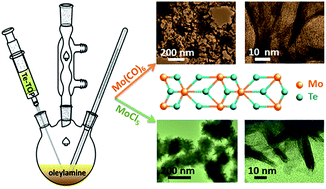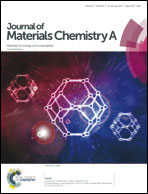Synthesis of few-layer 1T′-MoTe2 ultrathin nanosheets for high-performance pseudocapacitors†
Abstract
The synthesis of layered transition metal dichalcogenide nanocrystals with excellent properties in energy conversion and storage has been well documented in the past several years. However, due to the metallic character of Te, the realization of the chemical synthesis of uniform well-defined MoTe2 nanostructures still remains a challenge, especially to achieve metastable 1T′-MoTe2. In this work, we have developed a colloidal chemical strategy for the synthesis of ultrathin 1T′-MoTe2 nanosheets. The as-achieved sample was characterized by a layered-expanded feature with an interlayer distance of 0.723 nm and rich defects. The shapes of 1T′-MoTe2 can be controlled by varying Mo precursors and the reaction atmosphere, where CO plays an essential role in determining the nanosheet feature. Interestingly, the optimized few-layer 1T′-MoTe2 nanosheets can be used as an efficient supercapacitor electrode with specific capacitances of 1393 F g−1 and 714 F g−1 at current densities of 1 A g−1 and 100 A g−1, respectively. An asymmetric 1T′-MoTe2//activated carbon supercapacitor exhibits a maximum specific capacitance of 158.9 F g−1 with an energy density up to 56.4 W h kg−1. To the best of our knowledge, it is the first time that ultrathin MoTe2 nanosheets have been used as ideal electrode materials for supercapacitors. The present work highlights a facile synthetic strategy to realize uniform transition metal telluride nanostructures for enhancing their electrochemical performances.


 Please wait while we load your content...
Please wait while we load your content...